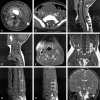MR imaging of the spine in epidermal nevus syndrome
- PMID: 12372757
- PMCID: PMC7976813
MR imaging of the spine in epidermal nevus syndrome
Abstract
We report two cases of epidermal nevus syndrome (ENS) involving the spine. MR imaging of the spine demonstrated intraspinal lipomas in both cases. Abnormal, enhancing, enlarged cervical and lumbosacral nerve roots were present in one patient. Spinal imaging for patients with ENS may help in the diagnosis of subtle intracranial manifestations, as it did in both of our cases. ENS has features similar to those of other neurocutaneous syndromes, such as neurofibromatosis type 1 and encephalocraniocutaneous lipomatosis.
Figures



References
-
- Atherton DJ, Rook A. Naevi and other developmental defects. In: Rook A, Wilkinson DS, Ebling FJG, Champion RH, Burton JL, eds. Textbook of Dermatology. 4th ed. Oxford: Blackwell Scientific,1986. :107–227
-
- Kotagal P, Rothner DA. Epilepsy in the setting of neurocutaneous syndromes. Epilepsia 1993;34:571–578 - PubMed
-
- Pavone L, Curatolo P, Rizzo R, et al. Epidermal nevus syndrome: a neurologic variant with hemimegalencephaly, gyral malformation, mental retardation, seizures, and facial hemihypertrophy. Neurology 1991;41:266–271 - PubMed
-
- Gurecki PJ, Holden KR, Sahn EE, Dyer DS, Cure JK. Developmental neural abnormalities and seizures in epidermal nevus syndrome. Dev Med Child Neurol 1996;38:716–723 - PubMed
Publication types
MeSH terms
LinkOut - more resources
Full Text Sources
Medical
Research Materials
